Walking to my office from the bus stop this morning while talking with a fellow bus rider, I wondered if Duke and UNC ever won national titles back-to-back. Checking the records books (okay, Wikipedia), I learned that the answer is yes! Duke won the national title in 1991 and 1992, followed by UNC in 1993.
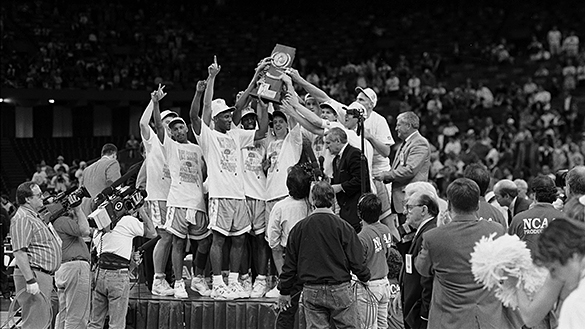
Hugh Morton traveled to Indianapolis in 1991 when both schools reached the Final Four. UNC lost its national semifinal to Kansas, coached by Roy Williams, 79 to 73. Morton hung around town and returned for the championship game to witness Duke’s downing of Kansas 72 to 65.

Morton did not make the trek to Minneapolis for Duke’s championship at the 1992 Final Four with UNC’s Southeast Regional loss to Ohio State in Lexington, Kentucky, but he certainly was not going know what it means to miss New Orleans in 1993. Follow the “1993” link to our story about that game, published in March 2013.
Duke was last years’s national champion. Will UNC follow in their footsteps this year and make history repeat itself?
Category: Sports
When last they met here
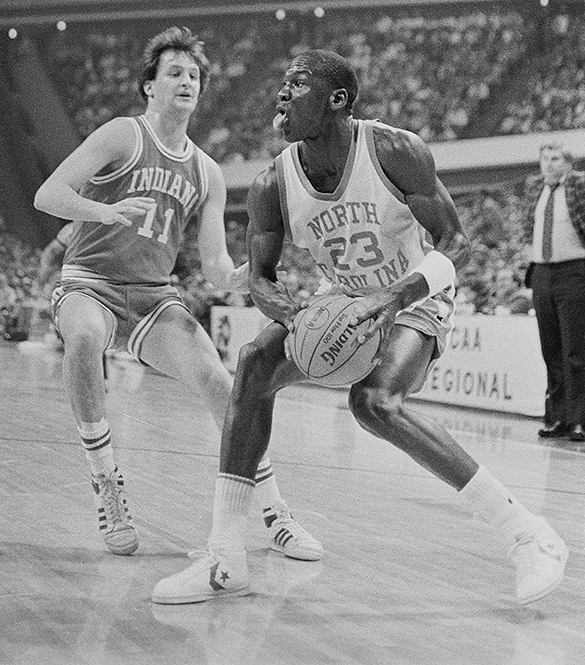
It was his last college game. An upset that still rankles a quarter-century later, like a large pebble in his Air Jordans.
—Mike Lopresti, sportswriter, March 3, 2009
This coming Friday night, the UNC Tar Heels will face the Indiana Hoosiers’ in the East Regional Semifinal of the NCAA Men’s Basketball Tournament in Philadelphia, Pennsylvania. The two schools last met in the East Regional semifinal round thirty-two years ago today on March 22, 1984 in Atlanta, Georgia. Michael Jordan played his last game as a Tar Heel that day, because the Hoosiers emerged with a 72-68 victory.
According to sportswriter Mike Lopresti, who wrote an article in 2009 titled “After 25 years, Jordan still frustrated by loss to Hoosiers in tourney,” Indiana head coach Bobby Knight made a few strategic changes that led to their upset win over the number one seed UNC: “He ditched his beloved motion offense and spread the floor, to better combat Dean Smith’s trapping defenses . . . and . . . put a blue-collar defender named Dan Dakich on Jordan. Dakich was ordered to deny Jordan the backdoor cut, the post-up and offensive rebounds. Fail at any, and he was on the bench. Dakich learned of his assignment a few hours before the game. Already ill, he went back to his room and threw up.”
Jordan fouled twice early in the game and it was he who spent unexpected minutes on the bench. Jordan told Lopresti in an interview: “When I got back in the second half, I felt like I was trying to cram 40 minutes into 20 minutes,” he said. “I could never find any sync in my game.”
A post last week listed all the NCAA basketball tournaments photographed by Hugh Morton. The list did not include 1984. Once I heard that these two teams would play against each there once again, I immediately flashed on a photograph I’ve had on my office door for several years until very recently:

I lived in Indiana for fourteen years before moving to North Carolina to work in the North Carolina Collection Photographic Archives, so it was a fitting photograph—my new state rising above my old state. What stuck in my mind’s eye, though, was the 1984 banner in the lower right corner. That’s when I knew I could add another tournament to Morton’s list. Checking the finding aid revealed that he also photographed the opening rounds played in Charlotte.
In the Morton collection there is one roll of 35mm black-and-white film and second roll of color transparencies. The latter are mostly substandard as Morton missed focused on most of his exposures. Only one color image is online; the description, however, did not mention that the game was in the NCAA tournament so it did not turn up in my search.
Today we (that is, our scanning technician) scanned the roll of black-and-white negatives and present three of Morton’s better photographs from the game.
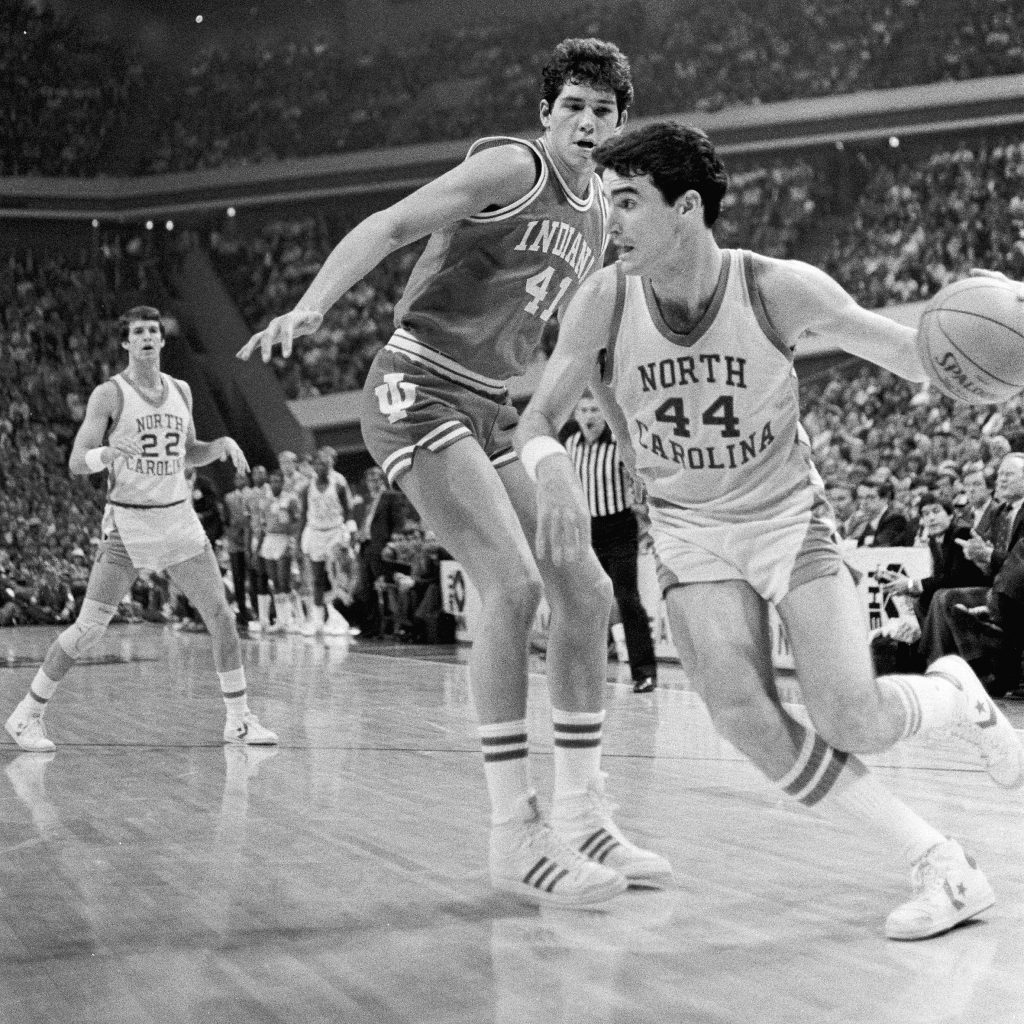
Hugh Morton photographs the NCAA Men's Basketball Tournament
Four years ago today, my fellow co-worker Bill Richards passed away while watching the Tar Heels play their “Sweet Sixteen” game against Creighton in the 2012 NCAA tournament. In addition to being an avid UNC football and basketball fan, Bill was the senior digitization technician in the Carolina Digital Library and Archives. In 1982 Bill was the Chief Photographer for the Chapel Hill Newspaper. In 1988, he began working as a photographer and graphic designer in the UNC Office of Sports Information. He began working in the Library Photographic Services unit in 1998, but continued working for Sports information into the 2000s. Each year at this time I dedicate a post about UNC basketball to Bill.

By my count, Hugh Morton photographed during seventeen eighteen more than twenty NCAA men’s basketball tournaments—in some years at multiple locations, such as 1991 when Morton traveled to East Rutherford for the East Regional and to Indianapolis for the Final Four. In last year’s post I counted fourteen, so below is an updated list with several new links to images in the online collection. Bill Richards would have loved this much detail! Did I miss any this time around?
- UNC’s loss in the 1946 championship game against Oklahoma A&M, at Madison Square Garden in New York.
- Duke’s defeat of Connecticut in the 1964 East Regional Final played in Raleigh’s Reynolds Auditorium.
- UNC’s victory over Davidson in the 1968 East Regional Final, also played at Reynold’s Coliseum.
- UNC’s 1969 “Final Four” loss to Purdue in the national semifinal played in Louisville, Kentucky. Morton also photographed the other national semifinal between Drake and UCLA, the eventual national champion.
- The 1974 national semifinals played in the Greensboro Coliseum, where North Carolina State upset of UCLA in the first round of the Final Four. Morton photographed the game from the stands, from where he also shot some of the Kansas versus Marquette contest. Morton did not photograph N. C. State’s win over Marquette for the national championship.
- 1975 first round win over New Mexico State played at the Charlotte Coliseum.
- The 1977 “Final Four” games versus the University of Nevada, Las Vegas, and Marquette University played at The Omni in Atlanta.
- UNC’s 1981 trip to Final Four at Philadelphia. The online collection includes photographs of the win over Virgina, but not the championship loss to Indiana.
- UNC’s 1982 journey to a championship victory over Georgetown at New Orleans, including trips to Raleigh for the East Regional games agains Alabama and Villanova.
- UNC’s 1983 defeat of Ohio State and its loss to Georgia in the East Regional Final played at Syracuse’s Carrier Dome.
- In 1984, Morton covered the East regional games played in Charlotte, and Indiana’s upset victory over top seeded UNC in Atlanta.
- UNC’s 1987 trip to The Meadowlands for its victory over Notre Dame in the East Regional Semifinal and the Tar Heels’ loss to Syracuse in the regional final.
- UNC’s 1992 appearance in the West Regional in Seattle, Washington; there are no game action photographs, however, only a UNC band trumpeter, a few sideline views of the UNC bench, and several dejected players inside and outside of the locker room. No images from this year are represented in the online collection.
- UNC’s 1990 upset over number one seed Oklahoma in the second round of the Midwest Regional.
- UNC’s 1991 East Regional games against Eastern Michigan and Temple at the Meadowlands in East Rutherford, N. J. Morton also went to Indianapolis for the Final Four. The online collection, however, on includes on one photograph of Kansas head coach Roy Williams talking to his assistant coach Matt Doherty, and two scenes after Duke won the national championship over Kansas.
- UNC’s 1992 Southeast Regional victories over Miami University (Ohio) and Alabama played in played in Cincinnati, Ohio, and their lose to Ohio State in Lexington, Kentucky. There are no photographs online from theses games, but they are represented in the collection.
- UNC’s 1993 national semifinal game versus Kansas and national championship win over Michigan, 77–71, in New Orleans; and UNC’s regional semifinal against Arkansas and the regional final victory over Cincinnati, both played at the Brendan Bryne Arena in East Rutherford, New Jersey. According to the Morton collection finding aid, Morton did photograph UNC’s regional game against Rhode Island, but there isn’t enough detail to see if he photographed the opening round game versus East Carolina. Winston-Salem hosted both of these games.
- UNC’s trip to the 1995 Final Four in Seattle, where they lost to Arkansas in the national semifinal.
- UNC’s trip to Indianapolis in the 1997 Final Four, where they lost to Arizona 66-58 in the national semifinal. Morton also photographed UNC’s regional game versus Colorado played in Winston-Salem.
- Morton’s final trip to the NCAA tournament sent him to San Antonio for the 1998 Final Four, when he photographed UNC’s national semifinal loss to Utah, 59-65.
The man responsible for transmitting The Madness
Prolog
It’s a curious malady that sweeps the ACC nation just before most of us catch spring fever. Many of us deal with the disorder by sitting in front of our TV sets for hours listening to basketball announcers and analysts drone on with a strange and curious language that only those who are infected with the ailment can understand:
“With the game on the line, he tickles the twine with the 3-ball from downtown, to get the “W” and advance to the next level of the big dance and now with a chance to win all the marbles up for grabs . . .”
It’s known as “March Madness” and there is no known cure.
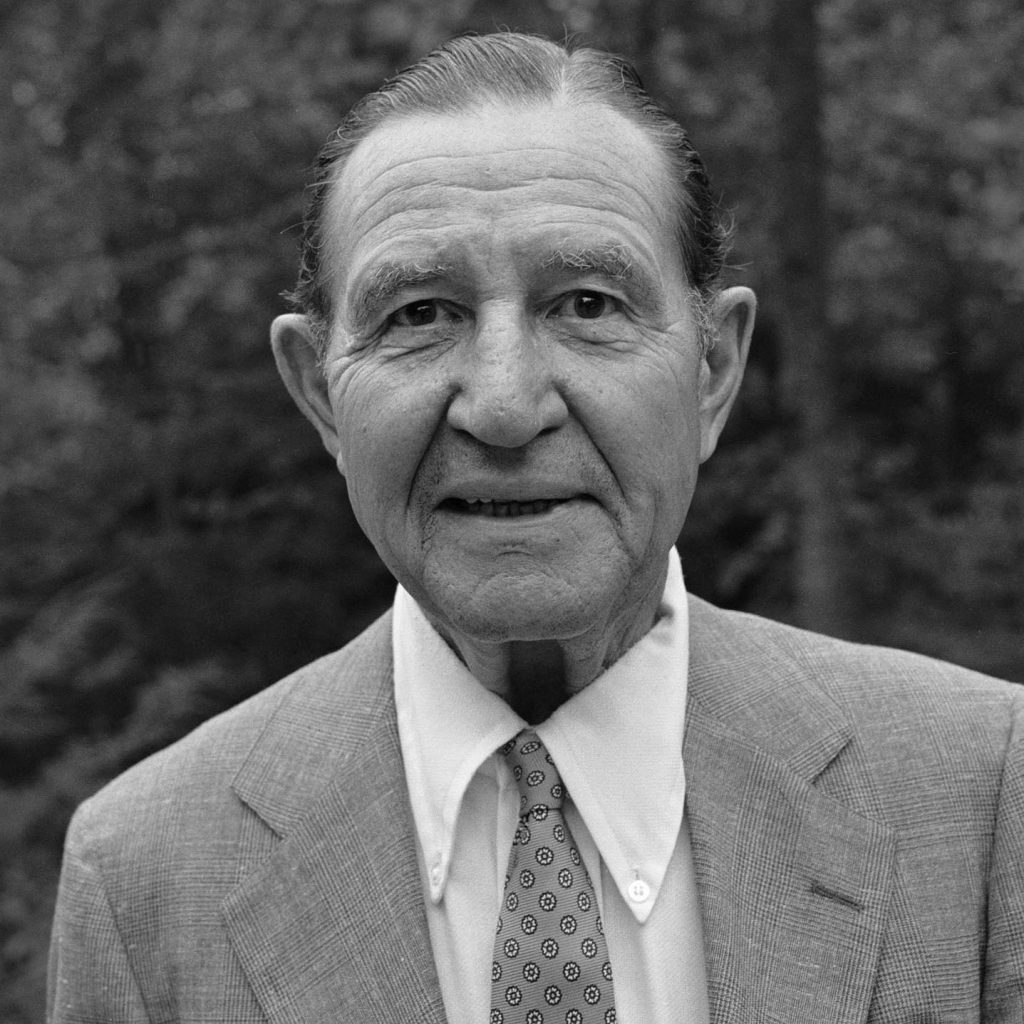
The Madness is upon us with the 2016 Atlantic Coast Conference Men’s Basketball Tournament on RayCom Sports and ESPN, but what would it be like without that wall-to-wall TV coverage? There was a time in the early days when ACC basketball was only on radio, but one man saw a bright future for the sport on TV.
Morton collection volunteer Jack Hilliard profiles the man who is often called the father of ACC basketball on television, C.D. Chesley.
He put ACC basketball on the map, about 10 years ahead of everyone else, and they are still trying to catch up.
Hugh Morton, March 8, 2003
In the early 1950s sports television was nothing like it is today. I remember as a little kid watching the Washington Redskins on Sunday afternoons at 2:00 on the Amoco Redskins Network. There were no replays, so in order to see a favorite play for a second time, I had to wait until the following Friday night when the local TV station ran a program called National Pro Highlights. The program, produced by a company in Philadelphia called Tel Ra Productions, showed filmed highlights of the preceding Sunday’s games.
Castleman DeTolley Chesley was a member of the production team at Tel Ra. Chesley had a football background having played freshman football at UNC in 1934. He then moved to the University of Pennsylvania where he was football captain and was also a member of the Penn traveling comedy troupe. Following graduation he became Penn’s athletic director, but he kept his finger on broadcasting’s pulse. Chesley later worked with both ABC and NBC coordinating college football coverage with the NCAA.
During the 1956–1957 college basketball season, Chesley became intensely interested in the UNC Tar Heels coached by Frank McGuire as they worked their way through an undefeated season. The 27-and-0 Tar Heels then beat Yale in Madison Square Garden during the first round of the NCAA Tournament. At this point, Chesley made his move. Being familiar with the NCAA ins and outs, he was able to set up a three-station regional network for the finals of the Eastern Regional played at the Palestra in Philadelphia. Although station WPFH-TV in Wilmington, Delaware was the switching point, the three stations were in Durham, Greensboro, and Charlotte. Matt Guokas, a former Philadelphia Warrior NBA star, called the play-by-play.
Even before Carolina had won the two-game regional in Philly, Chesley was already setting up the network for the national finals in Kansas City, Missouri and added two additional stations. The semi-final with Michigan State and the final with Kansas were both triple-overtime games. Some folks who watched those two games say that the madness for ACC basketball was born that weekend. Castleman D. Chesley would most likely agree with those folks.
The next logical step was to approach athletic directors at ACC schools about the possibility of doing weekly football and basketball games during the regular season. In the beginning, ADs and head coaches were not in favor of adding TV to the schedule. They were afraid that people would stay home and watch on TV, rather than attend the games. Chesley was able to convince them otherwise, pointing out how television could be used as a recruiting tool as well as fund raising opportunities.
On October 12, 1957 the first ACC football TV game was broadcast, a game from Byrd Stadium in College Park, Maryland between the University of Maryland and Wake Forest. Charlie Harville and Jim Simpson made up the on-air broadcast team. Three other games were telecast during the ’57 football season: one from NC State, one from UNC, and one from Duke. While the football games were successful, Chesley had his eye on basketball. On December 7, 1957, the first ACC regular season basketball game was telecast on a regional network. The game was Carolina vs. Clemson from Woollen Gym on the UNC campus.
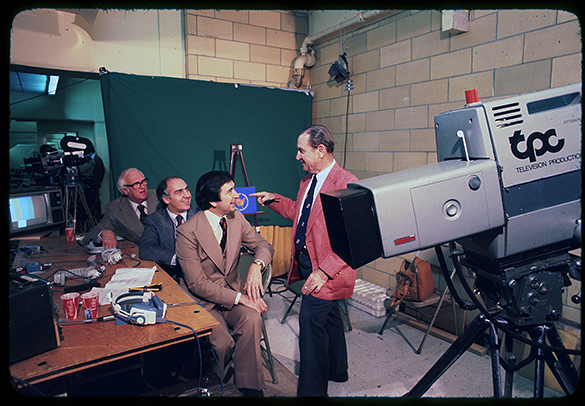
In those early days, the C.D. Chesley Company consisted of three people: Irving “Snuffy” Smith, Peggy Burns, and Mr. Chesley. From the beginning Chesley used equipment from WUNC-TV and students from the University’s Radio, Television, and Motion Picture Department. WUNC-TV’s director John Young managed the personnel and equipment. Play-by-play broadcasters like Harville, Simpson, Dan Daniels, Woody Durham, and Jim Thacker, and analysts like Bones McKinney, Billy Packer, and Jeff Mullins were brought in to handle the on-air while directors like John Young from WUNC-TV, Norman Prevatte from WBTV in Charlotte, and Frank Slingland from NBC-TV in Washington called the shots, often from an old converted Trailways bus that UNC-TV used in the early days.
Television coverage of ACC basketball caught on just like Chesley said it would, and his main sponsor Pilot Life Insurance Company became about as famous as the ACC teams. People across the ACC nation could sing along . . .
Sail with the Pilot at the wheel,
On a ship sturdy from its mast to its keel . . .
C.D. Chesley was pleased with ACC basketball but he was always looking for additional challenges. In 1962 and ’63 he produced TV coverage of the Miss North Carolina Pageant to a regional network of station across the Tar Heel state, and in 1964 he produced regional coverage of the Greater Greensboro Open Golf Tournament.
Chesley was always on the lookout for more football coverage. In the mid-1960s he started Sunday morning replay coverage of the preceding Saturday’s Notre Dame games; in 1967 was able to get Hall of Fame Broadcaster Lindsey Nelson to do the play-by-play and Notre Dame Heisman Trophy winner Paul Hornung to do the color commentary. At one point the Notre Dame games were featured on 136 stations and Nelson became known as that “Notre Dame announcer.”
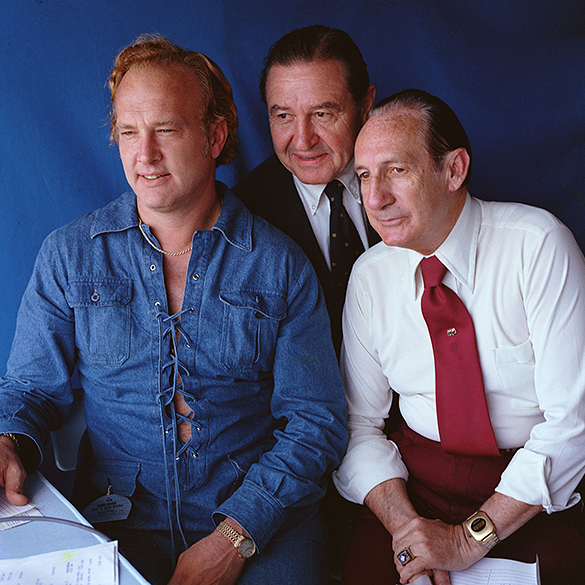
C.D. Chesley started small but his broadcasts were always first class productions. By the 1970s he was broadcasting two ACC basketball games a week. On January 14, 1973 just before the Washington Redskins met the Miami Dolphins in Super Bowl VII, Chesley put together a patch-work national network for the ACC basketball game between North Carolina State and Maryland. It was big time and NC State All America David Thompson became a national sensation.
The C.D. Chesley Company and ACC basketball continued as household names for twenty-four years through the 1981 season. At that point ACC basketball was so big that other broadcasters with bigger budgets wanted in on the action. Chesley’s one million-dollar rights fee could not compete with the likes of MetroSports who offered three million for the 1982 season and RayCom Sports of Charlotte who paid fifteen million for the rights for three seasons starting in 1983. RayCom continues today as the network for ACC basketball.
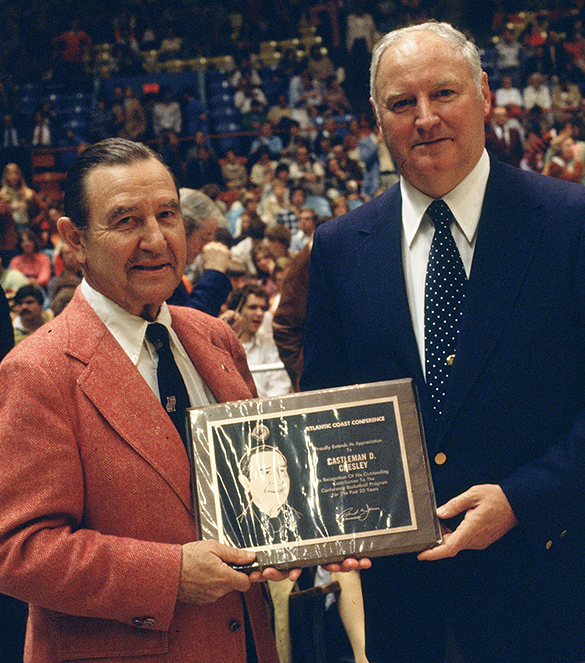
“His place in the history of ACC basketball is phenomenal, getting the sport out there in front of the public,” said Tar Heel broadcaster Woody Durham in a 2003 interview. “We all knew how exciting ACC basketball was, but here was a guy who came along and let the public see it.”
On April 10, 1983, Castleman D. Chesley lost his battle with Alzheimer’s. He was laid to rest in a small cemetery near his home at Grandfather Mountain. He was 69 years old.
Four years later the North Carolina Sports Hall of Fame inducted Chelsey in the spring of 1987. Hugh Morton and Ed Rankin, in their 1988 book, Making a Difference in North Carolina, devoted eight pages of words and pictures to “the man who put ACC basketball on the map.”
Charlie’s angel
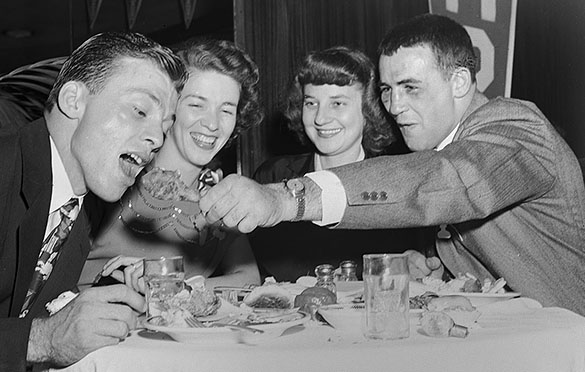
On this day twelve years ago, the state of North Carolina lost a treasure—and Morton collection volunteer Jack Hilliard and his wife Marla lost a dear friend. Sarah Alice Hunter Justice passed away in Shelby, North Carolina at age 79. Today, Jack Hilliard takes a look at the life and times of a very special lady.
She was an angel here on earth, the epitome of a lady, always a gleam in her eye, and she never raised her voice. —Jane Browne, Justice family friend, 2/18/04
It was early in the spring term, 1942, at Lee H. Edwards High in Asheville. Football star Charlie Justice knew he was going to be late for class, so he applied some of his football skills and began to run down the hall. In the process he ran over Sarah Alice Hunter. She laughed and didn’t make anything of it. Charlie was impressed, and later asked her out. A notation in the campus newspaper’s “Rumors Afloat” column on March 20th said, “Charlie looks like he’s finally settled down to one girl—Nice going Sarah.”
Following her graduation in May 1942, Sarah headed to Appalachian State in Boone, but decided to return home to Asheville at Christmas. Charlie finished at Lee Edwards on May 28, 1943, and was off to the Navy at Bainbridge Naval Training Station in Bainbridge, Maryland. He continued playing football, while Sarah took a job with the Naval Observatory in nearby Washington, D. C.
Ten days after Charlie led Bainbridge to a 46 to 0 win over the University of Maryland, he went on a well deserved leave. At the same time, Sarah took a brief leave from her job. The two headed to Asheville, where they were married at Trinity Episcopal Church on November 23, 1943.
Following his military obligation, Charlie and Sarah moved back to North Carolina and enrolled at UNC on Valentine’s Day, 1946. Since Charlie was eligible for the GI Bill, Sarah got his football scholarship, thus becoming the first female to attend Carolina on a football scholarship. In Chapel Hill, Charlie’s football heroics became legendary and on football Saturdays Sarah was always in the stands, cheering him on wearing her special good luck hat. On August 23, 1948, the Justice family increased by one with the birth of son Charles Ronald. (They called him Ronnie.)

Following his playing days at Carolina, Charlie signed on with the Washington Redskins for four seasons. In 1952, daughter Barbara joined the family and they returned to North Carolina in 1955, where they were often Hugh Morton’s guests at events in Wilmington and Grandfather Mountain. They especially liked the Highland Games and Gathering of the Scottish Clans each July.
Over the years, Charlie and Sarah offered their name, their time, their talent, and their money to just about every cause in the Tar Heel state from Chapel Hill to Asheville to Greensboro . . . from Hendersonville to Flat Rock and Cherryville. They were there when needed. Sarah gave much of her time to the causes that improve the lives of the mentally challenged. In Cherryville, she helped raise funds for Gaston Residential Services, which provides housing for the handicapped. The Special Olympics program was also close to her heart. In 1989, when the Charlotte Treatment Center named a wing of its facility for Charlie, they also named a wing of the facility for Sarah.

On June 11, 1993, Charlie and Sarah lost their son Ronnie…the victim of a heart attack. He was 44 years old. Following Carolina’s win over Duke 38 to 24 on November 26, 1993, a special celebration was held in the Carolina Inn on the UNC campus. While the win was celebrated, the real reason for the celebration was to offer sincere congratulations to Charlie and Sarah Justice on their 50th wedding anniversary, which was actually on November 23rd but game day three days later gave everybody a good reason for a celebration. The invitation for the event set the stage for the event:
A Golden Anniversary
Should be shared with family and friends.
Please join Billy, Barbara, Emilie
And Sarah Crews, Leah, David
And Beth Overman and in spirit
And loving memory Ronnie Justice,
In celebration of the fifty year
Marriage of Sarah and Charlie Justice.
There were family members, teammates, friends, and fans in attendance. Following a family toast by Barbara, Tar Heel Head Football Coach Mack Brown offered congratulations and spoke about the importance of Carolina’s football heritage. And throughout the ceremony, Hugh Morton was there with camera in hand documenting every phase of the event.
You didn’t need to be around Charlie Justice very long before it became very clear that his asking Sarah to marry him was the most important event in his life. Although she was often thought of as Charlie’s wife, Sarah Justice didn’t fit the old saying, “Behind every great man stands a great woman . . . .” Charlie and Sarah stood side by side . . . they were a team. They were connected. Their love story was the stuff of storybooks. Sarah was always there . . . but chose to be just outside the spotlight.
In a 1995 interview with Justice Biographer Bob Terrell, Charlie talked about how the “Hand of Providence” placed him at the right place at the right time: “If I hadn’t knocked Sarah Hunter down while scuffling in the hall in high school, she might never have noticed me. You bet that was providential!”
Soon after the Terrell biography was published in early 1996, Charlie began a seven-year battle with Alzheimer’s—a battle he would lose at 3:25 AM on Friday, October 17, 2003. A memorial service celebrating his life was held at The Cathedral of All Souls in the Biltmore section of Asheville on Monday, October 20th. Asheville Citizen-Times senior writer Keith Jarrett beautifully described the scene outside the church following the ceremony.
“It was one of several warm, touching scenes on a beautiful, cloud-free day with a sky the color of you know what. Sarah sat in a wheelchair just outside the Cathedral as the UNC Clef Hangers, an all-male a cappella group, softly sang James Taylor’s ballad ‘Carolina in My Mind.’ Sarah tilted her head and was just inches away from the singers. For a brief moment she closed her eyes, soaking in the words and perhaps recalling the memories of a marriage of love and devotion of 60 years.”
On November 4, 2003, I received a note from Barbara Crews: “Mother and I are at the beach. Mom loves the ocean. I think she has such peace now, she feels her job is done, and she did it well. . . . She is the best person I have ever known.”
There was a message on my answering machine when I arrived home from work on Monday, February 9, 2004. It was from Billy Crews telling me that his mother-in-law had passed away earlier that day. It had been 115 days since Charlie died. Marla and I had visited Sarah two days before on Saturday, February 7th at Hospice at Wendover in Shelby. Sarah Justice was 79-years-old.
In an article in The Charlotte Observer issue of Wednesday, February 18, 2004 titled “Caregiver more than Mrs. Choo Choo,” Gerry Hostetler talked with some of Sarah’s family. Son-in-law Billy Crews said, “She was always full of grace, and for her whole life a caregiver. She enjoyed doing things for other people and being out of the limelight.” Granddaughter and namesake Sarah Fowler added, “She was a very giving person who always put others’ needs in front of her own. She was the backbone of this family and kept us going.”
Finally, Barbara ended the interviews with this: “She was just a saint, the kind of person you want to be around.”
A bowl of bitter sugar and an impromptu New Year’s Day truck ride in the Big Easy
The 2015 Tar Heels season ended disappointingly Tuesday evening at the Russell Athletic Bowl in Orlando, Florida. The game marked Carolina’s 32nd bowl appearance, but sadly for Tar Heel fans it became their 18th bowl loss. Of the 31 previous bowl games, the Tar Heels won 14 and lost 17—and of those losses, the one on January 1, 1949 was “one that got away.” Morton collection volunteer Jack Hilliard looks back at the final three games of the 1948 regular season and the 1949 Sugar Bowl.
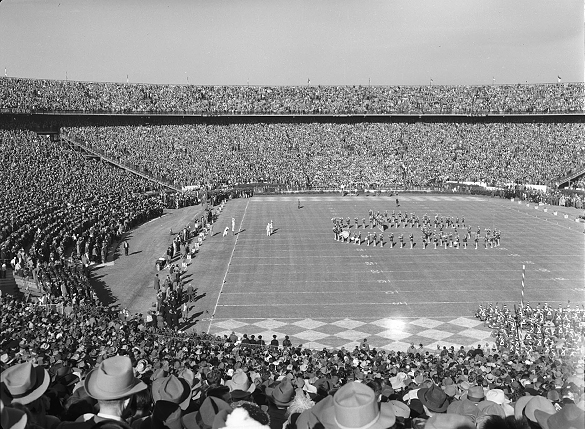
When UNC Head Football Coach Carl Snavely walked off the Kenan Stadium sideline on November 6, 1948, Carolina’s bowl-game-future wasn’t likely on his radar. His third ranked, undefeated Tar Heels had just played William and Mary to a 7-7 tie. His team was looking at three tough games remaining: Maryland in Washington, D. C.; Duke in Chapel Hill; and Virginia in Charlottesville.
On Sunday, November 7th Snavely was back at his home on Tenney Circle in Chapel Hill screening film of head coach Jim Tatum’s Maryland Terrapins. A record Washington football crowd of 34,588 turned out for the game at Griffith Stadium, with an estimated 6,000 Tar Heel fans in attendance. Carolina was able to reverse the proceedings from the previous week’s 7-7 tie, and dominated Maryland 49 to 20.
An interesting oddity from that Maryland game was the game day program. There were two different programs: one cover showed a standard Lon Keller designed football player, while a second one offered a Hugh Morton image of Charlie Justice and Coach Snavely. The inside front cover page of that program also differed from the standard program. It featured a Bill Harrison cartoon biography of Justice.
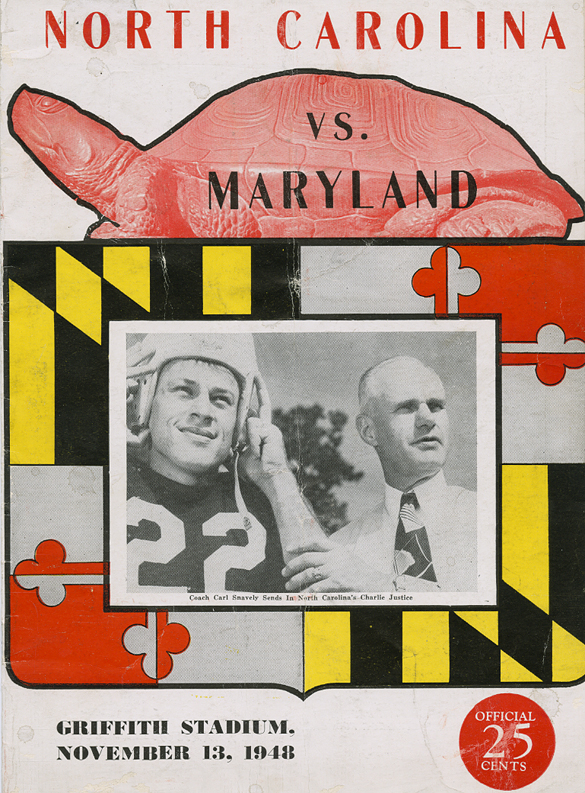

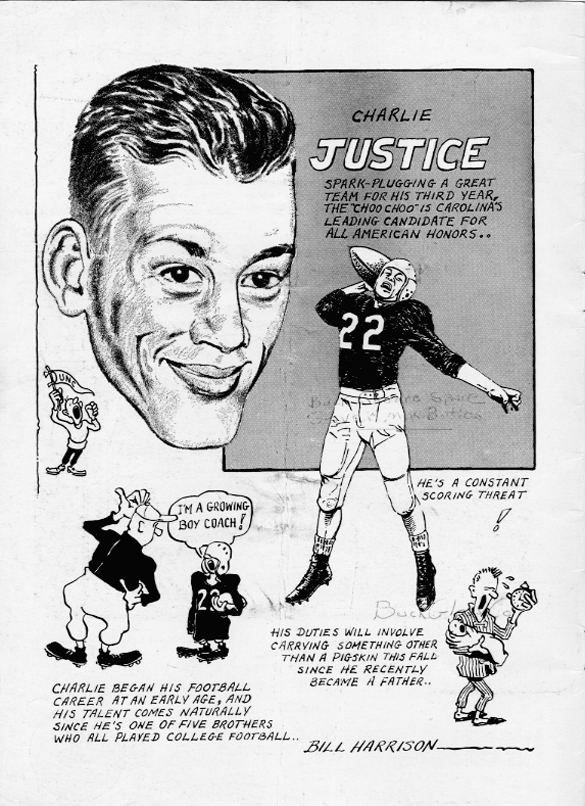
The weekend following the Tar Heel victory over Maryland saw another record-breaking crowd packed into historic Kenan Stadium for the 35th meeting between Duke and Carolina. 44,500 fans saw Charlie Justice’s 43-yard touchdown run break a 0-0 tie in the 3rd quarter as Carolina went on to claim the first Victory Bell win 20 to 0. Following the game, Coach Snavely said “I never saw a better run.” In a time long before the internet, Hugh Morton’s shot of Justice being carried off the field went viral and has been reproduced numerous times over the years.
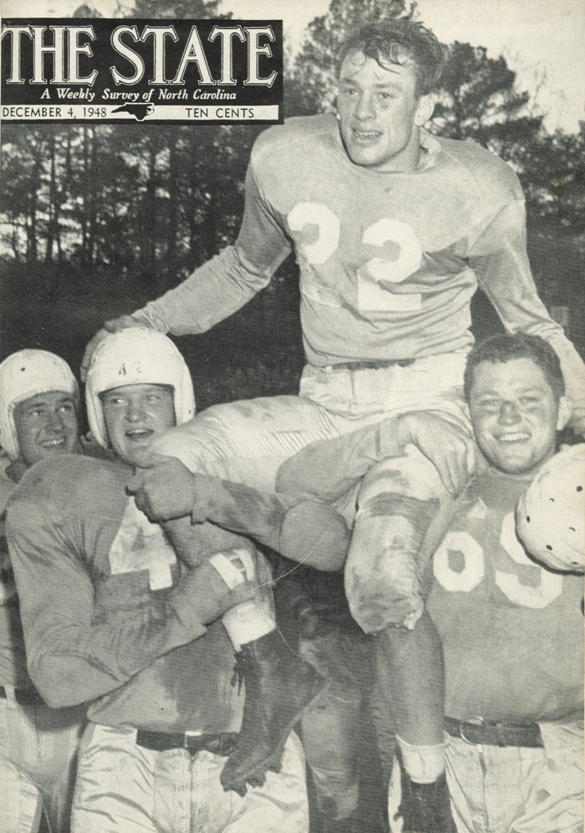
Next up . . . the ‘Heels and the ‘Hoos in Charlottesville.
The week before the UNC–UVA game on November 27th, bowl-talk filled the newspapers. The Orange, Cotton, and Sugar Bowls all showed an interest in the Tar Heels. On November 22nd the Carolina team voted to accept a bowl bid if they could beat Virginia in the final game of the ’48 regular season. The players liked the idea of playing SMU in the Cotton Bowl or Oklahoma in the Sugar Bowl, but a New Year’s Day game all hinged on a win in Charlottesville.
An overflow crowd of 26,000 jammed into Scott Stadium in Charlottesville on November 27, 1948 to see the UNC’s number four ranked Tar Heels take on the Cavaliers of Virginia. Carolina scored on its first possession and added two additional touchdowns to lead at halftime 21 to 6. That additional touchdown was spectacular. Carolina had the ball at its own 20-yard line. Justice took the snap, paused momentarily, then ran through a huge hole between left guard and left tackle supplied by Bob Mitten and Ted Hazelwood. Justice then outran Virginia’s Billy Marshall to the end zone 80-yards away.
Colorful halftime entertainment was provided by the Lenoir NC High band. The Tar Heels couldn’t score in quarter number three, but picked up two touchdowns in the final stanza. The final Tar Heel TD was another Justice beauty: a 50-yard run down the sideline behind fantastic blocking to seal the 34 to 12 win and complete an undefeated season, the first one since 1898.
Following the game at the Albemarle Hotel, which was UNC headquarters while in Charlottesville, head coach Carl Snavely announced that his Tar Heels would meet the Sooners of Oklahoma on January 1, 1949 in the 15th annual Sugar Bowl in New Orleans. Said the coach, “We got what we wanted . . . .”
An interesting sidebar to the ’48 Carolina–Virginia game involved a future president of the UNC system. C. D. Spangler, Jr. became president of the consolidated university system in 1986. Following Dr. William Friday, Spangler continued in that position until 1997; on November 27, 1948, however, he was an 11th grade student at Woodberry Forest, and was one of the 26,000 fans that jammed into UVA’s Scott Stadium to see Carolina play Virginia. Leading the Tar Heels that Saturday afternoon was junior sensation Charlie Justice. On one of Charlie’s plays, his number 22 jersey was torn. Equipment manager “Sarge” Keller quickly got out a new one, tossing the torn one over behind the bench. Spangler quickly called a Carolina cheerleader over and made a deal to get the torn jersey. He kept the prized souvenir for over fifty years. Then on November 20, 1999, during halftime of the Carolina–Duke game, Spangler presented the jersey to then UNC Athletic Director Dick Baddour and it is now in the Charlie Justice Hall of Honor at the Kenan Football Center on the UNC campus. And of course Hugh Morton photographed the jersey presentation ceremony.
Off to New Orleans
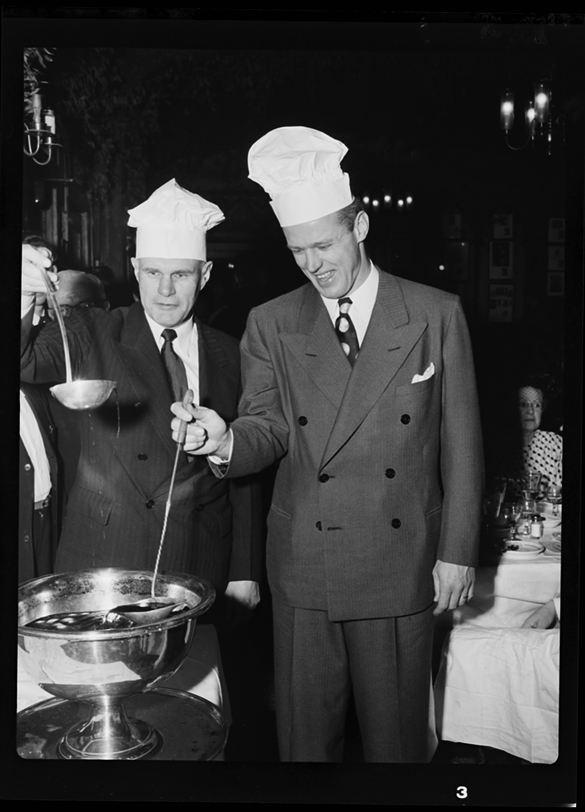
The majority of the ’48 Tar Heel football squad arrived by plane at its Sugar Bowl training site in Hammond, Louisiana at 4:30 PM on December 19th…the additional 15 members of the traveling party arrived by train later that evening. In the second group was Tar Heel end Art Weiner and his bride of three days. Southeastern Louisiana College played host the Heels. Training started on the 20th and continued through the 24th. A quick trip to New Orleans for Christmas Day…then it was back to Hammond for more practice.
Many Tar Heel fans traveled to the Crescent City, too. As an earlier post recounted, several, including Hugh Morton, managed to have some exotic fun in New Orleans.
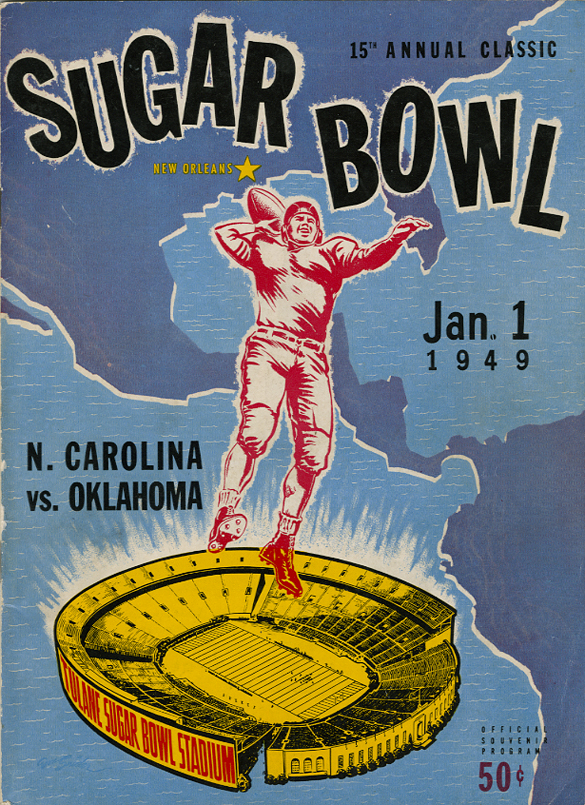
An early Saturday morning return to New Orleans on January 1st signaled the start of the big day as a record 85,000 fans jammed into Tulane Stadium, including photographer Hugh Morton who had working arrangements with several North Carolina newspapers including the Charlotte News, Greensboro Daily News, and High Point Enterprise.
Carl Snavely’s third-ranked UNC Tar Heels were primed and ready for Bud Wilkinson’s fifth ranked Oklahoma Sooners as was ABC’s national television audience. (The TV was not available back in North Carolina because the AT&T long lines had not been completed into the state and wouldn’t be until September 30, 1950, so the folks back home were tuned to Harry Wismer on the ABC Radio Network). Prior to the kickoff, Coach Snavely and Justice, who had been a bit under the weather all week, posed for Morton’s camera along with ABC broadcaster Wismer.
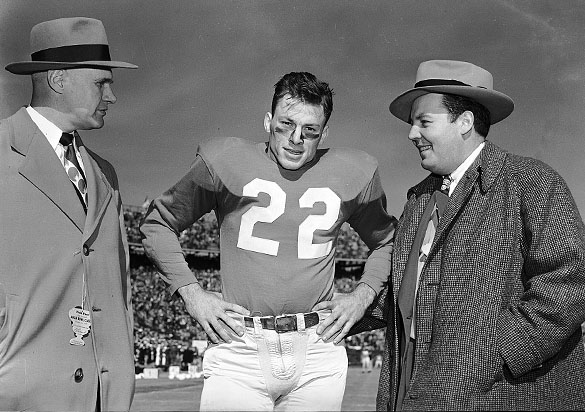
Then it was time for some football.

Carolina’s first-possession-drive started at its own 37, and with Justice leading the way moved swiftly down to the Oklahoma 15 on seven plays. Then, Justice’s pass to Bob Kennedy in the flat was a bit late, and Oklahoma’s Myrle Greathouse intercepted and was off to the races. Tar Heel Eddie Knox finally caught him 72 yards later at the Carolina 13. It took the Sooners eight plays to score and take a 7-0 lead at the 8:10 mark.
On Oklahoma’s next possession, Lindell Pearson fumbled and Carolina’s Joe Romano recovered at the Sooner 30. Four plays later, Hosea Rodgers scored—after being set up by a nine-yard run by Bob Kennedy to the Oklahoma three. Bob Cox’s PAT attempt was wide right so the score at the 13:55 mark was 7 to 6.
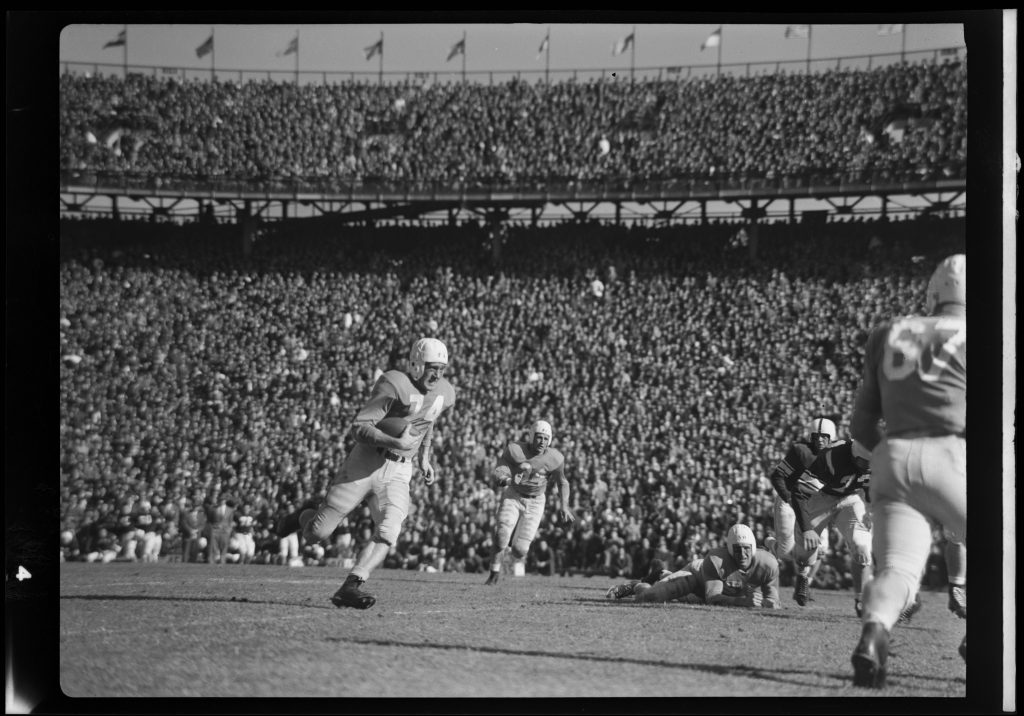

With four minutes left in the second quarter, Carolina started a 10-play drive that ended up at the Oklahoma 7. The big play in the drive for the Heels was a Charlie Justice 23-yard run plus a lateral to Chan Highsmith that added 11 more yards to the Sooner 7.
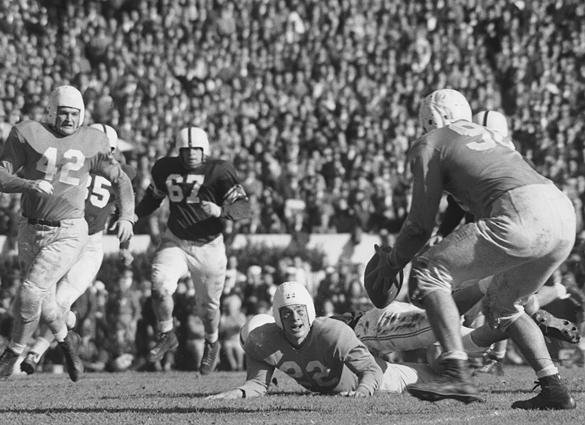
Then four passes failed—one of which many old time Tar Heels will never forget. As time was running out in the first half, Justice went back to pass. He had Art Weiner wide open in the end zone, but Weiner was not able to make the catch. “Justice threw me a perfect pass,” Weiner recalled in a 1976 interview. “I was supposed to cut toward the sideline on the left. Darrell Royal (a future University of Texas head coach) was the defensive back and I had to get away from him. Charlie threw perfect, I was more concerned where Royal was than the ball. I took my eye off the ball. . . Had I known Royal actually fell down . . . it was a sure touchdown.”
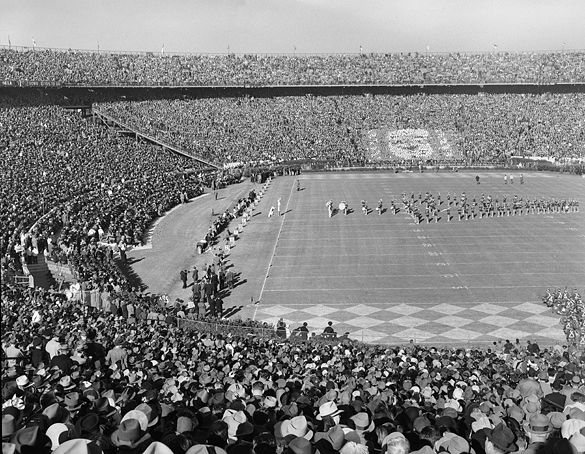
Oklahoma led 7 to 6 at the half.
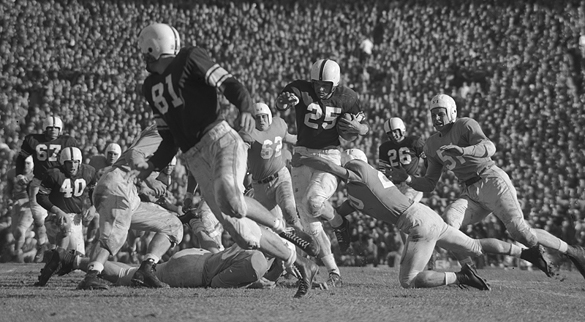
During the first nine minutes of the second half, nothing much happened. Then, with the ball near midfield, Oklahoma halfback Darrell Royal threw long for end Frankie Anderson who was finally tackled by Johnny Clements at the Carolina 10. Ironically, this would be Oklahoma’s only pass completion of the game. Two plays later, the Sooners scored at the 9:40 mark of the third quarter. The remainder of the game became a punting duel between Justice and Royal…a duel that Justice won easily with punts of 65, 65, 57, and 53 yards.
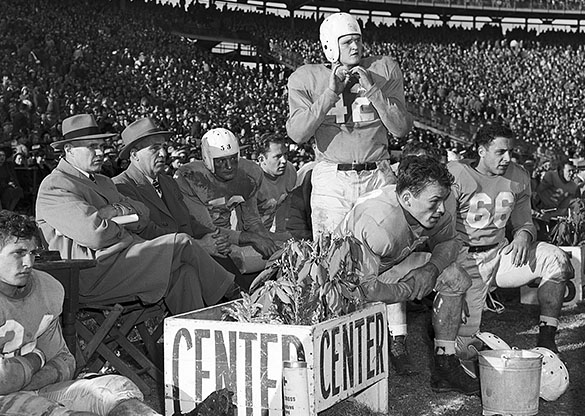

With two minutes left in the game, Hugh Morton turned his camera toward the Carolina bench. His remarkable picture of a dejected Charlie Justice tells the story of the entire afternoon. The picture has been reproduced numerous times over the years.
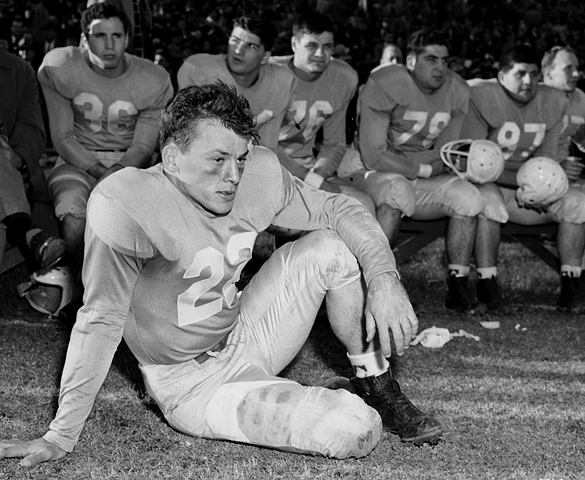
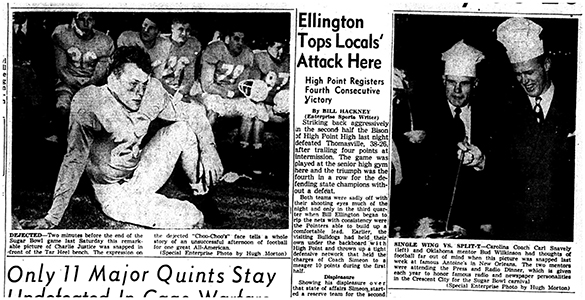
Following the game, both head coaches weighed in on the proceedings. Oklahoma Coach Bud Wilkinson said, “There is no question that Charlie Justice is great. He was the player we feared the most and he showed that he is a great back.” Carolina head man Carl Snavely said, “Oklahoma had a big, fine, rugged team and played smartly.”
High Point Enterprise Sports Editor Bill Currie, writing colorfully in the late edition on January 1st said, “Errors in execution, judgment, and strategy on the part of the North Carolina Tar Heels helped the rapacious red-jersied hoard of Oklahoma Sooners to a 14-6 victory in the 15th annual Sugar Bowl game here today . . . .”
After all the interviews were completed, the weary UNC Tar Heels made their way slowly to their locker room as darkness fell on Tulane Stadium. Justice took the defeat hard: once in the dressing room, he sat in the corner with a blanket over his head and cried. That picture of the Tar Heel hero turned up in the 1949 University of Oklahoma Yearbook, “Sooner.” The caption: “Grief-stricken . . . Charlie Justice . . . .”
About ten minutes later, he looked up and told the reporters who had gathered around him, “Well, I threw that one away. I gave them that first touchdown with that bad pass. You can say that.”
The Carolina players took their time in getting dressed, hoping the upset sting would go away. There was a post-game party scheduled but nobody was really in a party mood. Finally, long after the Oklahoma team had left, the Tar Heels came outside to a dark, deserted parking lot. The busses that had been scheduled to take the Tar Heels back to the hotel had mistakenly taken the Sooners. Then when the Oklahoma busses arrived and the drivers learned that their victorious Sooners had already left, they too left.
After a futile search, coach Snavely along with his assistants flagged down a passing truck. The team stood in the open back end as the driver headed toward the hotel. As the truck got close to the St Charles Hotel, the driver told Snavely, “Ya’ll have to get off a couple of blocks from the hotel. I’m not allowed to drive to the entrance.”
So, in the New Orleans darkness, UNC’s 1948 Tar Heels slipped in a hotel side entrance unnoticed, and showing the good sportsmanship that Coach Snavely demanded of his players, celebrated with their Sugar Bowl opponent. Viewing Hugh Morton’s photographs from the celebration in the Greensboro and High Point papers, it’s hard to tell who won and who lost.
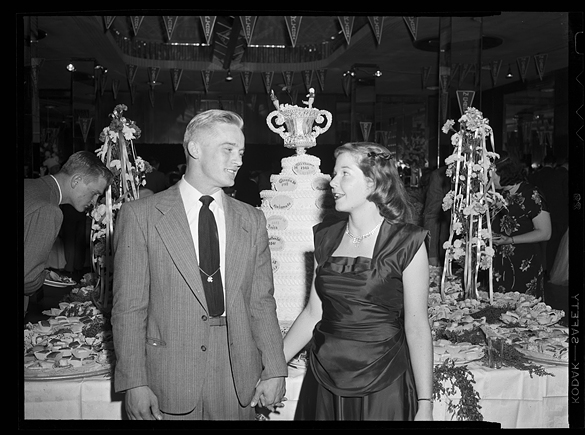

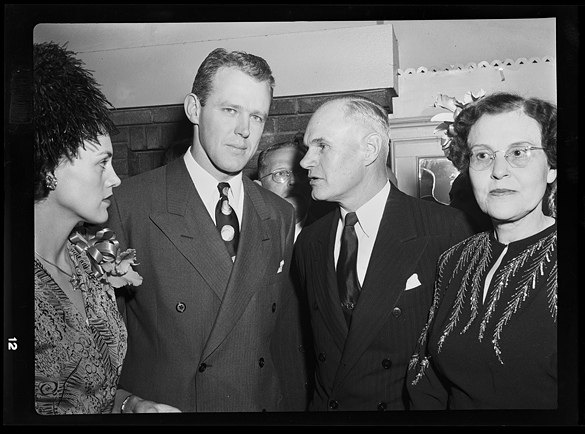
At 4:15 on January 4th, the majority of the Tar Heel team landed at Raleigh-Durham Airport and boarded busses for Chapel Hill. Two weeks later, Athletic Director Bob Fetzer received a check for Carolina’s participation in the 1949 Sugar Bowl, a check for $103,081.48.
Meadow George Lemon III, 1932–2015

The moon is not ready for us yet, so we must live together here on earth . . .
I woke up this morning to the news that Meadowlark Lemon passed away yesterday. I logged into A View to Hugh to create a blog post. Jack Hilliard had already left a comment about Lemon’s passing in Susan Block’s essay, “Wilmington: Faded Glory to Fresh Achievement” and he mentioned the above booklet. I retrieved it from the stacks first thing after arriving in my office. Leafing through its pages alludes to why the city conveyed the honor to Lemon when it did—but it never even mentions the exact date, only “on a day in March 1971.” Lemon’s visit to Wilmington lasted forty-eight hours (maybe more) and took place only six weeks after the February 6th firebombing of Mike’s Grocery and the rioting that followed, and the arrest of suspects that became known as The Wilmington Ten. Lemon’s autobiography, Meadowlark (1987) tells part of the story, too, a story that extends beyond an honorific day.
Born Meadow George Lemon III on April 25, 1932 in Wilmington, North Carolina (though some sources state he was born in South Carolina and his family moved to Wilmington when he was about six years old). When Lemon was eleven years old he saw a newsreel at The Ritz movie theater about the Harlem Globetrotters. Lemon’s heart raced as he watched the players handle a basketball, passing it around their “Magic Circle” with faking and mugging while dancing to the music of “Sweet Georgia Brown.” He couldn’t believe what he was seeing. “In a flash,” he wrote in Meadowlark, “I knew I wanted to be on that team, the Harlem Globetrotters.” As soon as the newsreel ended, Lemon ran out of the theater, skipping the feature films, to his father’s house. He had had a life-changing experience and he had to tell his dad—but he wasn’t home. Rummaging around he found a nearly empty onion sack and threaded it onto a wire hanger, which he nailed the crudely made hoop to a neighbor’s tree. He went back to his dad’s house and found a Carnation Evaporated Milk, which he scrunched for his ball. He played basketball this way for hours until his father came home.
Meadowlark Lemon’s story of his basketball origins proceed through Wilmington’s Community Boy’s Club where he played his first organized basketball just after finishing sixth grade and continued learning the game there into his freshman year at Williston Industrial High School, the city’s only black high school. During his first basketball game as a freshman he played as a substitute center for an injured teammate against Laurinburg Industrial with their star forward and guard Sam Jones—a future Boson Celtic and NBA Hall of Fame inductee. Lemon was green and outplayed by the Laurinburg center; the next year, however, Lemon was named all-state and continued to be a star player throughout high school. He graduated from Williston in 1952
After graduation Lemon was indecisive about going to college despite dozens of scholarship offers. His father decided for him and sent off Meadow by train to Florida A&M. Lemon thought he had also earned a football scholarship there but he had not. Unhappy and unwilling to wait until basketball season, after just a few weeks he returned to Wilmington, prepared to serve in the U. S. Army having received his draft notice while away.
Upon Lemon’s return from Tallahassee his high school coach told him the Globetrotters would be playing in Raleigh in two weeks. His coach had previously written a letter requesting a tryout on behalf of Lemon to his friend Abe Saperstein, owner of the Globetrotters, but had never heard back. Lemon asked his coach to call Saperstein and secure a tryout for the Globetrotters while they were playing in Raleigh. His call was successful: all Lemon had to do was get to the arena in Raleigh and ask for Marques Haynes. Much to Lemon’s surprise, he tried out by suiting up for the game. Haynes was nursing an injured knee and decided Lemon could show him what he had on the court during the game. As he enter the gym wearing the colors he had only seen as black-and-white in a newsreel, the announcer read from a slip of paper: “For the first time in a Globetrotter uniform, the Trotters present Meadow Lemon, from our own Wilmington, North Carolina.”
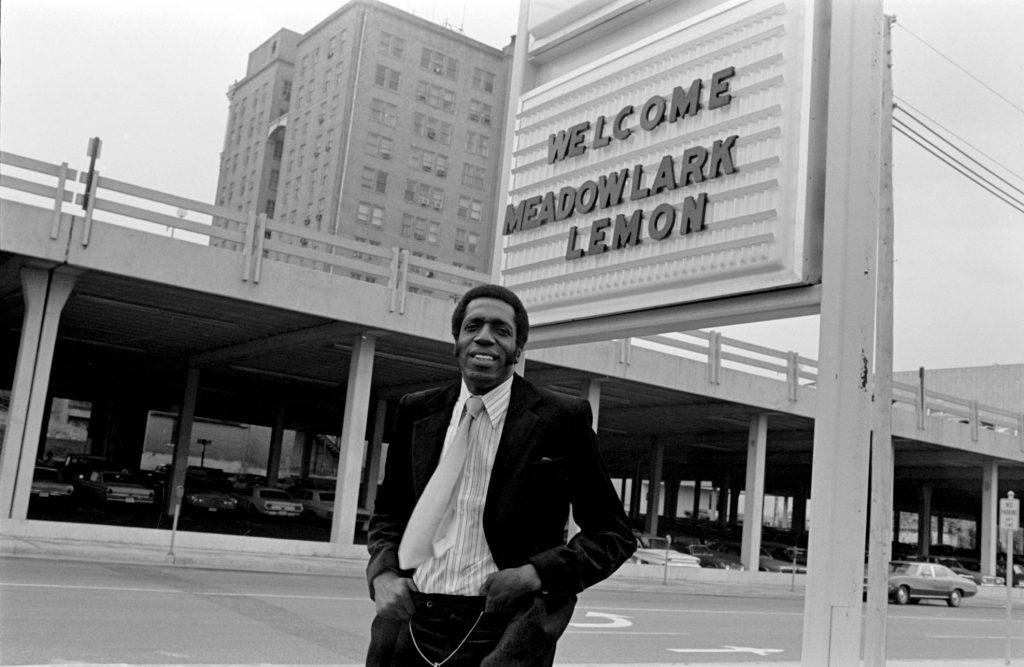
There’s plenty more to Lemon’s story, which indeed took him around the world as a Harlem Globetrotter. In 1971, however, Wilmington needed Lemon back home.
According to the booklet His Home Town’s Tribute, talk of having a Meadowlark Lemon Day dated as far back as 1965. So in late 1970 when the Wilmington Jaycees scheduled the Globetrotters for a date at Brogden Hall for March 1971, the Chamber of Commerce was quickly able to form a special committee that included city and county government officials, and educational and civic leaders. Shedding more light on those developments, Hugh Morton wrote in his profile of Meadowlark Lemon in Making a Difference in North Carolina (1988):
Tom Jervay, editor and publisher of the black-oriented Wilmington Journal refers to [Lemon] not as the “Clown Prince of Basketball” but as the “Clown Apostle of Interracial Good Will.” Jervay, whose newspaper office was one of several places bombed or burned in the spring of 1971 during a period of racial violence, remembers that his son, Tom Jervay, Jr. and former Wilmington Jaycee Ed Godwin telephoned from the Journal office to Lemon, whose Globetrotters were playing in Charleston, S. C. at the time, to invite the basketball star to help Wilmington. Goodwin arranged for a private plane to bring Lemon to the trouble city.
Editor Jervay says, “Meadowlark really cooled things down here when we needed him.” Looking back on the strife in Wilmington which he helped defuse, Meadowlark says he would do it again, but that he will never have to, because things like that happen due to ignorance on the part of both whites and blacks, and “all of us have grown.”
Meadowlark Lemon Day was Friday, March 19, 1971. The previous day’s editorial column in the Wilmington Star News began with the headline, “The trouble here must stop now!” Earlier that week racial tensions erupted into riots at Williston Junior High School (Lemon’s former high school, then recently integrated), Hoggard Junior High School, and New Hanover High School. The school district closed the three schools for Thursday and Friday.
According to a photograph’s caption the tribute booklet, Wayne Jackson interviewed Lemon on television Thursday evening. On set with Lemon was Earl Jackson and Walter Bess of the Community Boys Club, and Hugh Morton as a member of the Chamber of Commerce committee. (For context, in December 1971 Morton would begin his short-lived Democratic Party gubernatorial race.) On Friday Lemon appeared for a press conference, followed by a luncheon with city and county officials at the Timme Plaza ballroom. He then visited schools, including Williston, and the Community Boys Club. Lemon stressed the need to work together to get the schools open. In Meadowlark, Lemon says he told students, “Get the education. Stay in school. Let’s get things together and get this trouble over.”
The tribute booklet includes a letter from Lemon in which he acknowledges the importance of the Community Boys Club in his life. He noted that in two to three years the club’s outdated facility would fall inside the Urban Renewal area and would be torn down. He added,
At that time a new and better home for the Club must be built. I am grateful to Tom Jervay, Jr. and Hugh Morton for contributing, without cost, the pictures and text of this book, and to the Greater Wilmington Chamber of Commerce for publishing it. All profits from the sale of this souvenir book of the greatest day of my lifetime will go to begin the capital account that has been established in the Wachovia Bank in Wilmington to help build a new Community Boys Club.
There is so much good to be done in the world, I know I cannot do it all, but in the part of it I can do I want Community Boy’s Club to be included. The moon is not ready for us yet, so we must live together here on earth, and the Boy’s Club makes life mean more to a lot of young boys. . . .

In Meadowlark, Lemon devoted about three pages to his account of events and circumstances surrounding Meadow Lark Lemon Day. He recalled being flown into Wilmington five straight days before the game. Despite concerns that violence may break out during the game, none occurred. Lemon wrote in his autobiography, “No threats, no staring down. Blacks and whites sat together, laughed together, sang together. I felt it was one of the best things I ever accomplished.”
Closing Note: Were you living in Wilmington during this time? Do you have recollections about Meadowlark Lemon’s visit? If so, what level of importance do you place on his role at that crucial time? Please share your experience by leaving a comment. I believe there’s more to be learned about this topic!
Number 1 and only one (so far)
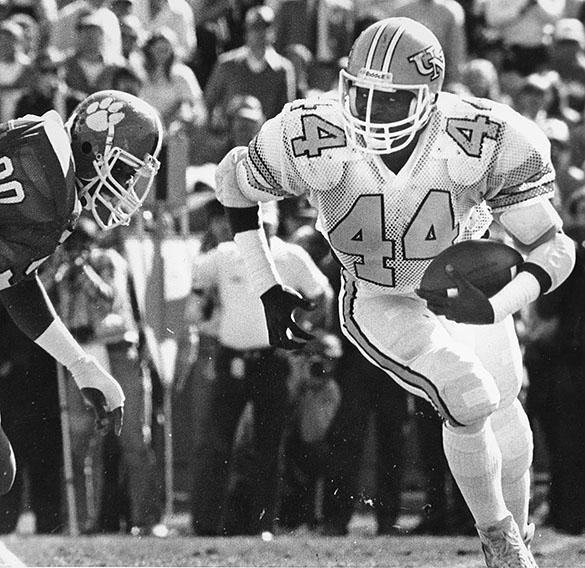
Prolog: Today, December 5th, at 8:00 P.M. UNC Head Football Coach Larry Fedora’s 2015 Tar Heels will take on head coach Dabo Swinney’s Clemson Tigers for the Atlantic Coast Conference Championship. Clemson (12-0) is ranked #1 and Carolina (11-1) is ranked #8 in both the Coaches’ and Football Writers’ polls. The game, which will be played in Charlotte’s Bank of America Stadium, will bring back some memories for some old Tar Heels. At the end of the 1948 season, Clemson (10-0) was at the top of the Southern Conference while Carolina (9-0-1) was second. Ironically, the two teams did not meet in ’48 but the final Associated Press poll placed Carolina #3 and Clemson #11. All of that took place five years before the ACC was born.
Introduction: UNC’s football tradition and heritage runs deep: thirty-one bowl games dating back to the 1947 Sugar Bowl, fourteen bowl wins dating back to the 1963 Gator Bowl, a host of All-America players dating back to 1934 and George Barclay’s selection, five players and two coaches currently in the College Football Hall of Fame dating back to Charlie Justice’s selection in 1961. There is one distinction, however, that only appears once in the Tar Heel record book and it occurred sixty-seven years ago. Hugh Morton collection volunteer Jack Hilliard takes a look back at that one-of-a-kind-honor.
When the 1947 football season ended and the final Associated Press poll came out on December 8th, the University of North Carolina was ranked ninth with eight wins and two losses. The ’47 Tar Heels received several minor bowl invitations, including one from the Legion Bowl that was to be played in Los Angeles, but the team and the university turned down the invitations.
However when the 1948 preseason football magazines hit the newsstands in early August, at least one mentioned the Tar Heels in the same sentence as the words “national title.” Durham sports columnist Jack Horner, (Hugh Morton jokingly called him “Little Jack Horner”) writing in Street and Smith’s 1948 Football Pictorial Yearbook said, “The Tar Heels of North Carolina . . . have the team to beat for Southern Conference honors but they’re a leading contender for the 1948 mythical national title.” Greensboro columnist Smith Barrier wrote the following in the 1948 Illustrated Football Annual: “A strenuous schedule that opens with Texas and follows with Georgia gives the Tar Heels opportunity to win tall place among the seasons great football powers.” When all the columnists’ ink had dried, it was time to play ball and see if any of the predictions would come true.

First up . . . a Kenan Stadium match-up between coach Carl Snavely’s single-wing North Carolina Tar Heels and coach Blair Cherry’s T-formation Texas Longhorns. There was no pre-season Associated Press poll in those days, but both teams would have most likely been in the nation’s top five.
On Thursday afternoon, September 23, folks in 10-gallon hats started showing up on Franklin Street. Texans were in town for Saturday’s season opener and were looking to take up where they left off the year before when they crushed the ’47 Tar Heels 34 to 0 in Austin. A sell-out crowd of 44,000 filled historic Kenan Stadium on Saturday, where fair, cool weather was in order.
Carolina’s barefooted kicker Mike Rubish kicked to Texas to start the game and Billy Pyle returned it to the Longhorn 22. Two running plays got nothing, so on 3rd down, Frank Guess quick-kicked to Charlie Justice who faked a hand-off to Johnny Clements, then took off down the sideline for 38 yards to the Texas 42. A drive that included a reverse play to Clements was capped with a touchdown pass from Justice to Art Weiner to put the Heels ahead. When Bob Cox converted the extra point, the game was only 3:30 old.
![This photograph (cropped) appeared in The Charlotte News on September 29 with the caption, "MR. WINGBACK at North Carolina this year is Johnny Clements, successor to Johnny Camp in the single wing attack ably executed by Carl Snavely & Co. A defensive halfback last year, Clements went on the offense as well this year, and Saturday ripped off a 22-yard gain on Carolina's first play from scrimmage to set the stage for the blitz touchdown. The Texans present are Landry [sic?] (33), Fry (60), and One-Punch Kelley (70). Wilmington's Sunday Star-News also published the photograph with slightly wider cropping.](https://blogs.lib.unc.edu/morton/wp-content/uploads/sites/7/2015/12/P081_NTBF3_6_2_1_1_106_585px.jpg)
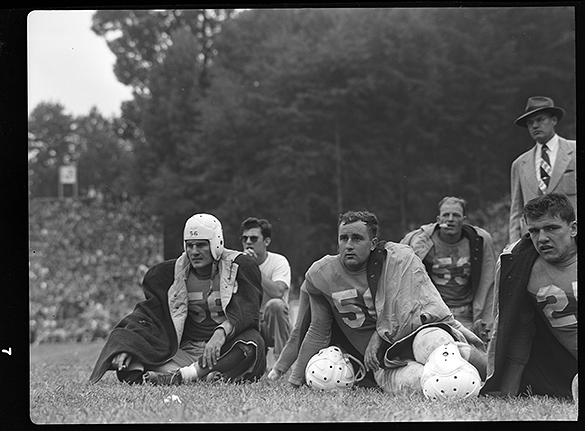
Two plays later it was Justice for Carolina’s second score. The game was now 4:30 old. Again Texas couldn’t move the ball on the Tar Heel defense and again Carolina drove for a third score—this time it was Justice passing to Cox. As Justice came off the field, Coach Snavely stood up from his normal seat beside the Carolina bench to shake Charlie’s hand. Said Justice, “Just sit down coach, it’s over.”
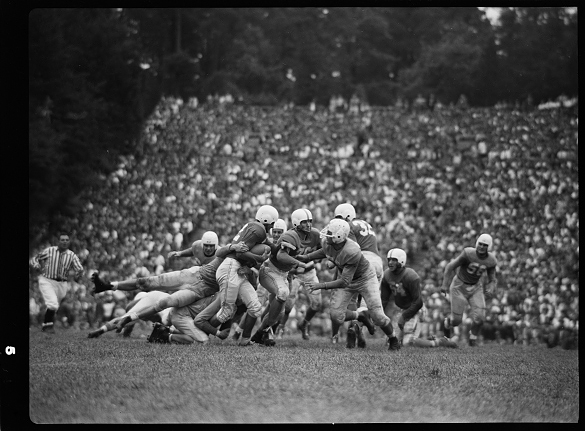
Texas was finally able to score near the end of the first quarter. Following a scoreless second quarter, the Kenan crowd was entertained by Head Cheerleader Norman Sper’s colorful 2,000-team card section along with Professor Earl Slocum’s marching band.
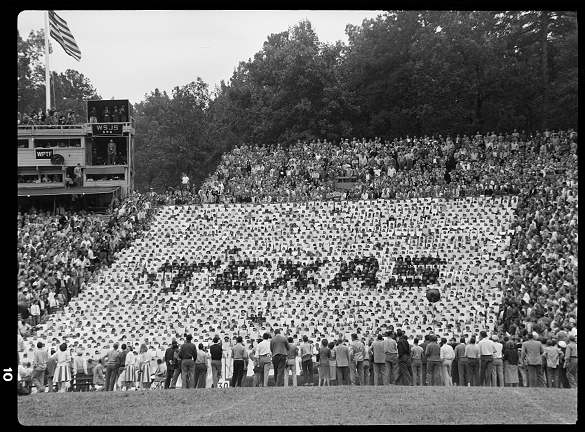
After a scoreless third quarter, it was Justice again, this time for 9 yards and a TD. The final Carolina score came on a Billy Hayes one-yard plunge, making the final 34 to 7.
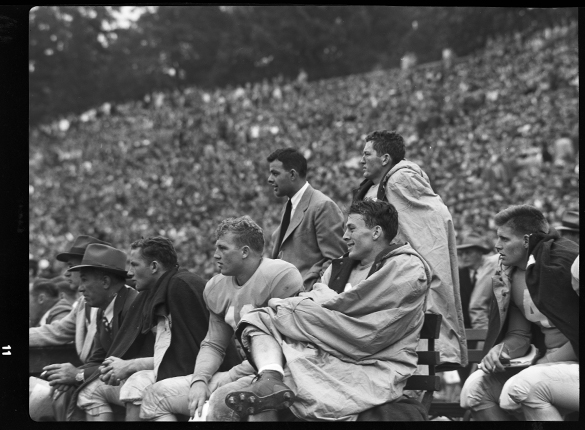
A Kenan celebration with Snavely riding the shoulders of his team broke out following the game. The sports headline in the Greensboro Daily News on Sunday morning, September 26th read: “Justice Shines; Foe Outclassed.” To this day, there are many old Tar Heels (like me) who say this was UNC’s greatest Kenan Stadium win.
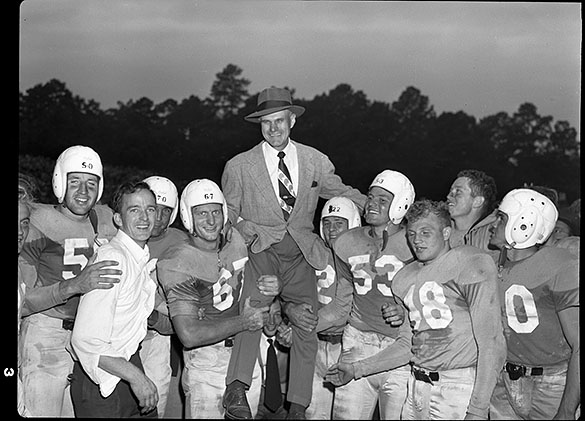
Three days later on September 28th when the Paul B. Williamson Football Ratings came out, Carolina was rated number one; most Tar Heel fans, however, anxiously awaited the all-important Associated Press Poll that would not be available with its first 1948 edition until October 4th—and the Heels had a road trip to Athens, Georgia before then.
Saturday, October 2, 1948 was a hot, 80-degree day in Georgia, but that didn’t stop 500 Tar Heel fans from staging a pre-game, traffic-blocking pep rally and parade through the streets of Athens led by UNC Head Cheerleader Norman Sper. The rally made its way through the UGA campus ending up at Sanford Stadium where 43,000 fans were ready for some football, and Georgia Head Coach Wally Butts was ready for game number two of his 10th season with the Bulldogs.
The 2:30 pm game began at the opposite end of the spectrum from the Tar Heel–Texas game the Saturday before. Carolina couldn’t seem to do anything right and the Bulldogs scored on a 76-yard-pass interception just six minutes into the game. That 7 to 0 score held into the third quarter when, with 10 minutes left in the quarter, Charlie Justice took control of the game scoring touchdown runs of 9 and 13 yards. Then in the 4th quarter it was Justice again—this time an 84-yard punt return to seal the Tar Heel victory, 21 to 14.
It turned out to be Justice’s greatest game as a Tar Heel: 304 total yards and his record performance prompted an article in the October 11, 1948 issue of Time titled “The Jack Rabbit of Chapel Hill,” complete with an Associated Press game action photograph. UNC Sports Information Director Jake Wade called the article “somewhat shy of accuracy.”
The game story in Sunday’s The Atlanta Journal went like this: “Charlie Trippi and Frank Sinkwich moved over Saturday to make room for Charlie (Choo Choo) Justice. Neither of the Georgia All-Americas ever dominated a football game on Sanford field one whit more than did the North Carolina express.”
Billy Carmichael III writing in The Daily Tar Heel issue of Sunday, October 3, 1948, had this to say about the game and his dear friend Charlie Justice:
The Tar Heels arrived early, stayed late . . . scored . . . and then packed up their play things and went home.” . . . (Justice) ran through them, he ran over them, he ran around. He passed to an assortment of receivers, picking his man like chocolates from a Whitman’s Sampler.
Georgia Assistant Coach Louis Trousdale said following the game, “It was all Justice . . . We coached our kickers for six months to kick away from Justice, and you see what happened.”
In a post game interview, Justice simply said, “It was the greatest game I ever played.”
The Tar Heel Nation faithfully awaited Monday’s Associated Press Poll, and most thought that Carolina would be number one for the first time in the history of the poll and the history of the school. Sadly, when the first AP Poll for 1948 was published on October 4th the Tar Heels were number 2 behind powerful Notre Dame. “Just wait ‘til next week” was the cry of the Tar Heel faithful.
Next up was a road trip to Groves Stadium and a match-up with “Peahead” Walker’s Wake Forest Demon Deacons. And for a second time during the ‘48 season, the Heels were looking to avenge a 1947 defeat. The headline in the High Point Enterprise issue of October 7th read, “Stop Justice, Deacons Say is Main Problem and Hope for Win.”
On October 9th, a record crowd of 28,500, including photographer Hugh Morton, packed Groves Stadium on a warm, sunny afternoon for the 45th meeting between Wake Forest and Carolina, a series dating back to 1888.

The Tar Heels played both ends against the middle, scoring twice in the first quarter and twice in the fourth quarter to take a 28 to 6 win. That 19 to 7 Wake win in ’47 was all but forgotten. The headline in the High Point Enterprise issue of Sunday, October 10th read: “Justice, Rodgers Pace Carolina to Third Win,” and Enterprise sports writer Bill Hackney followed up the headline by saying: “Charlie Justice and Hosea Rodgers sparked the Tar Heels’ offensive unit as they ate up 170 yards on the ground alone.” Justice and Rodgers outgained the entire Wake team on the ground by 60 yards. Morton’s action shots of Justice are classics.
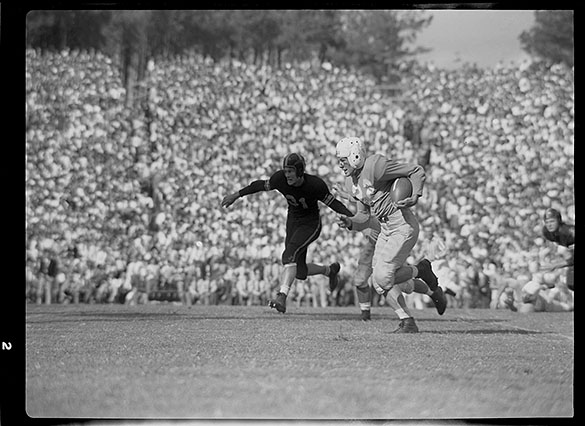
On Monday, October 11, 1948 it happened. Carolina took over first place in the Associated Press weekly poll. The Tar Heels got fifty-two first place votes and beat out Notre Dame by eighteen votes. It was headline news across the state and nation. The sports headline in the October 13th issue of The New York Times proclaimed, “Gridiron Poll Led by North Carolina.”
Legendary Associated Press sportswriter Will Grimsley said: “The Irish (of Notre Dame) who held the No.1 position for almost a year, were dumped to second place by North Carolina, a Dixie institution where a lad named Charlie Justice gets his higher learning.”
Austin Bealmear, another of the AP writing team added the following in The Greensboro Record: “Unbeaten North Carolina moved to the top of the class today as the country’s No. 1 college football team. The Tar Heels displaced Notre Dame at the top of the list in the weekly poll of sports writers from coast to coast, conducted by the Associated Press.”
So, when NC State came into Chapel Hill on October 16th for Homecoming 1948, they faced the AP’s No. 1 team. And again, Head Cheerleader Norm Sper, along with card section designer Bill Harrison, was ready with a big US map with a large No. 1 in the center. But a 14 to 0 Tar Heel win over State wasn’t enough for the Heels to retain the No.1 spot, as Coach Snavely predicted in his Monday morning press conference. “Look,” said the low-key head coach, “our team is overrated. Yes, we have a good team, but not a super team. . . We have our definite limitations and weaknesses. And I don’t believe that we are entitled to the high position assigned us in the national ratings.”
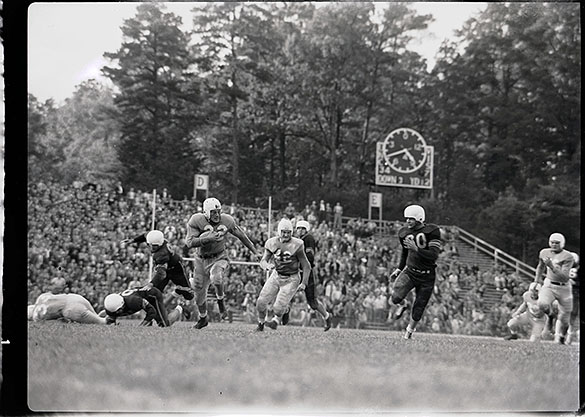
On October 18th Carolina slipped to third behind Michigan and Notre Dame. A 34 to 7 win over LSU in Kenan and a 14 to 7 win over Tennessee on Shields-Watkins Field in Knoxville failed to improve on that third place position. And then, disaster in Kenan: more about that in the A View to Hugh piece titled “A Game Fit to be Tied” posted back on November 4, 2015.
For sixty-six seasons, the Tar Heels have struggled to regain that No.1 ranking from the Associated Press. So far, they have not been able to achieve what the ‘48 Tar Heels did on October 11, 1948.
UNC versus NCSU football
The University of North Carolina Tar Heels and North Carolina State Wolfpack football teams face off this weekend, the final regular season game for both squads. The two schools first played each other in 1894, UNC emerging victorious with a score of 44 to 0. Hugh Morton was not yet born, but he likely would have photographed the game if he had been around to focus a lens and click a shutter.
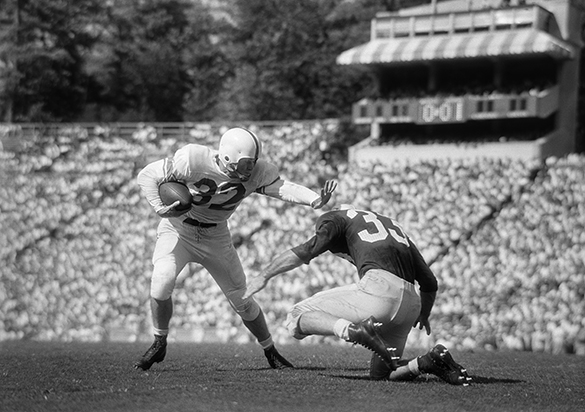
The photograph above, made during the 1954 contest won buy UNC 20 to 6, is one my favorite Morton football photographs. A print from that negative is part of the Hugh Morton retrospective exhibition, which will be displayed in Raleigh during 2016.
Based upon the earliest negatives located to date, Morton began photographing the annual contest in 1941 when he was a junior at UNC. Someone stole Morton’s camera soon after arriving on campus as a freshman in 1939, and he did not replace it until sometime in early 1940. There are no negatives in the collection that have been identified from the fall 1940 contest played in Raleigh. In 1941 when home field returned to Kenan Stadium at Chapel Hill, Morton was the staff photographer for the student newspaper and the yearbook. On November 2 The Daily Tar Heel published the following photograph on the front page.
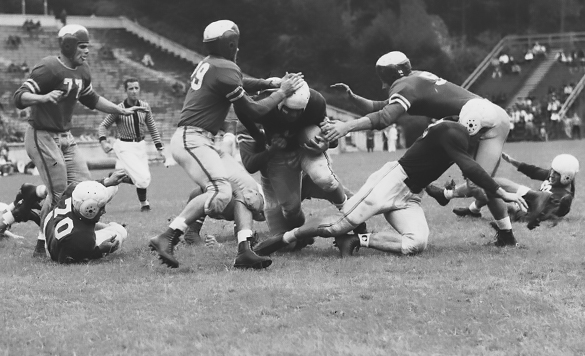
The Yackety Yack published that photograph plus the following from that game, which N.C State won 13 to 7—its first victory in the rivalry since 1927.
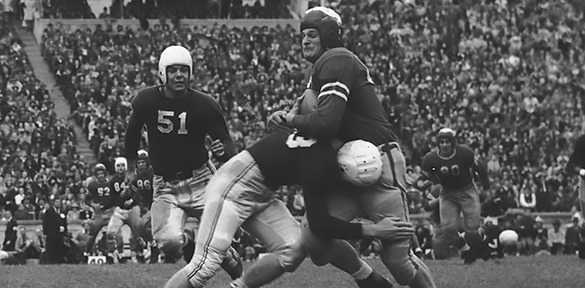
Below you can see the full negatives without cropping.
Morton enlisted in the United States Army in the autumn of 1942, making the 1941 game the only UNC versus NC State game that we know (thus far) that he photographed as a student. To find other Morton photographs from UNC—NC State football games, including Andy Griffith’s famous “What it Was Was Football” routine, visit the online collection of Morton photographs.

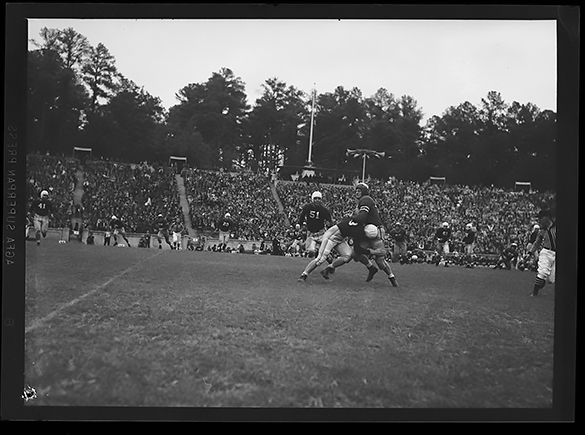
“Ties” that bind
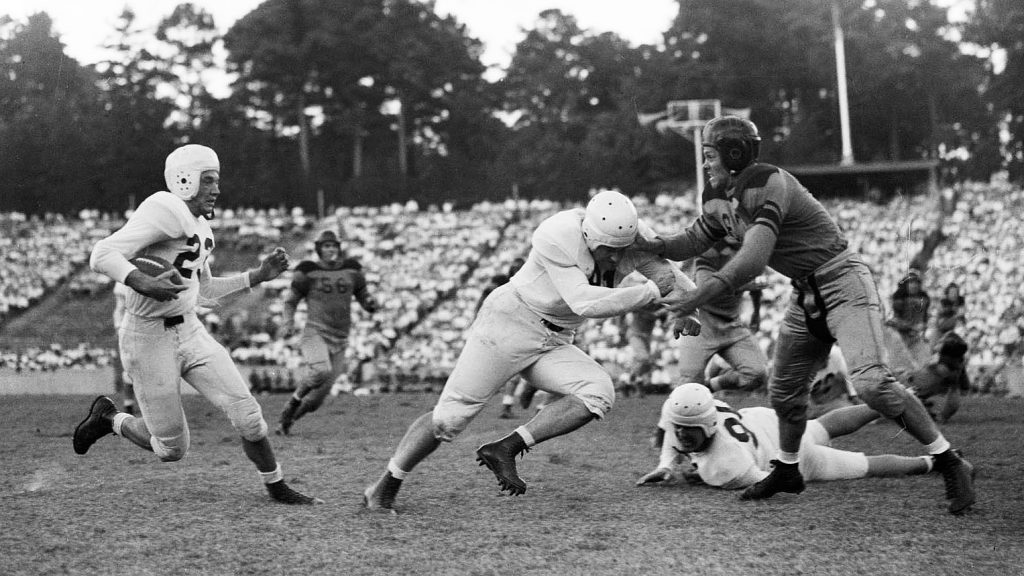
Back on November 4th, we included a post about the famous UNC vs. William & Mary tie game from 1948. Today, following Saturday’s game between UNC and Virginia Tech, Morton collection volunteer Jack Hilliard takes a look at the other tie game from the “Golden Era” of Carolina football.
After the regulation sixty minutes of play this past Saturday (11/21/15) at Lane Stadium in Blacksburg, Virginia, the scoreboard read UNC 24–Virginia Tech 24. Six previous games during the history of the series between these two teams ended in ties. The difference on this day in 2015: the NCAA rules now extend play into a tiebreaker overtime, during which Carolina was able to win 30 to 27.
Five of those previous ties (1896, 1900, 1902, 1906, and 1911) ended up 0 to 0, and since there was no overtime before 1996, those games are in the record book ties. The other tie, in 1946, is the one many old time Tar Heels remember. It was September 28, 1946 when VPI (now Virginia Tech) came into Chapel Hill to meet the Tar Heels in a game that opened the “Golden Era,” or “Charlie Justice Era” as some like to call it. Photographer Hugh Morton was on hand to document this historic game.
UNC wingback Jim Camp, running Head Coach Carl Snavely’s famous reverse, accounted for 50 yards of offense during that Saturday encounter.
On the first play of the second quarter, Charlie Justice had a 68-yard touchdown run and Carolina led at halftime 14 to 0. But in the second half, Justice had two punts blocked that led to VPI scores making the final score 14 to 14. Charlie finished the day with 100 yards rushing on 10 carries. Justice never had another punt blocked during his football career: 39 regular season and 3 bowl games at UNC, plus 58 games with the Washington Redskins and 6 UNC Blue-White games in Chapel Hill.
Ironically, Virginia Tech would not return to Chapel Hill for a game until Saturday, November 6, 2004—the day following the dedication of the Charlie Justice statue.
